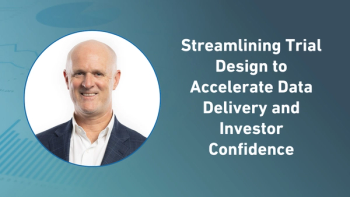
Eliminating the Three Evil "E's" in Starting Clinical Trials
Pharma has been transitioning from its paper based methods of the past toward automated cloud based systems in order to offset the cost of drug development. The emphasis is now shifting toward improved study startup processes for shorter clinical trial timelines.
In an effort to confront the oft-mentioned costs of drug development, the clinical trials industry has been evolving from its slow paper-based methods and standalone spreadsheets towards automated, cloud-based systems. There has always been a strong focus on study conduct and quality. But as stakeholders are increasingly aware that better study startup (SSU) processes are linked to shorter clinical timelines, the emphasis is shifting in that direction.
According to research conducted by the Tufts Center for the Study of Drug Development (CSDD), it takes an average of 17 months to get from protocol approval to 100% approved sites initiated for a clinical trial. Site activation costs $1,500 per site per month, or approximately $25,000 on average to get one site up and running. Since, on average, Phase II through IV studies have 82 sites per study, this can mean a total study startup cost of over $2 million.
Study startup complexity
Study startup is the multistep practice of selecting and preparing investigative sites required to conduct clinical trials. It is a collaboration of stakeholders: sponsor, CRO, site, institutional review board (IRB) or ethics committee (EC), and a variety of outsourced providers. The study startup phase for clinical trials has historically been a time-consuming, labor intensive and costly process that consists of a number of related activities:
• Site identification and activation/initiation
• Conducting investigator meetings/site training
• Regulatory document completion and IRB/EC approval
• Negotiations of contracts and budgets
• Planning for patient recruitment
• Managing/tracking regulatory documents, including:
- Site feasibility survey forms
- Protocols
- Investigator brochures
- Site contracts
- Budget worksheets
- Patient recruitment plans
- Informed consent forms
- Advertising materials
• Drug accountability
• Provision of supplies and test article
Improving SSU efficiency is imperative to sponsors’ and CROs’ bottom lines and to accelerating trials, with deep process-based issues that can’t be addressed by simply increasing human capital alone.
Manual processes in study startup
Technology has allowed big advances in clinical trial efficiency, ranging from entry of clinical trial data via electronic data capture (EDC) to managing study documents in the electronic trial master file (eTMF). But, up until the last few years, the SSU portion of clinical trials has not benefited from these innovations, essentially remaining manual or heavily rooted in Excel spreadsheets. These manual processes have long hampered efforts in study startup, with diverting resources from more critical tasks to the manual routing and tracking of forms.
And recent research conducted by Tufts CSDD in 2016, examining practices and inefficiencies in site selection, study start and site activation, indicates not much has changed. The research shows that, despite advancements in technology, researchers are not conducting SSU any faster today than they did 20 years ago. Site activation cycle time (the amount of time it takes to identify a site and get it activated) was found to average around 14 months.1
Site contract cycle times also contribute to stagnation in SSU duration. KMR Group analyzed recently assessed global industry site contract cycle times. The study evaluated 20,000 recently-executed contracts for Phase II and III trials from biopharmaceutical and found that overall site contract cycle times have doubled from an industry median of about 1.5 months in 2010-2011 to over three months in 2014-2015. Even contracts conducted in North America, traditionally a top performer, have increased from 1.3 months in 2010-2011 to 2.4 months in 2014-2015.2
As in other areas of study execution, the manual Excel process has been found to contribute to inefficiencies because it lacks data sharing and collaboration capabilities, real-time data, and lacks of documenting, tracking and analyzing clinical trial data. A paradigm shift is needed in order to eliminate the three evil “e’s” – email, Excel, and e-meetings (teleconferences with remote study team members) – long associated with starting clinical trials.
Improving SSU efficiency with technology
With all the inefficiencies introduced into clinical trials by the three evil e’s, there is a growing acceptance that workflow technologies are a better choice for streamlining SSU processes, with the potential to ultimately reduce timelines and improve data quality. Real-time reporting negates the need for status meetings, where dated, manually prepared reports are reviewed for budget and timeline compliance. Time isn’t wasted assembling and discussing reports; instead, all stakeholders view this information in real-time via their technology solution, well ahead of any scheduled meetings. This empowers the decision making process, as clinical study managers access automated, at-a-glance status.
SSU software tools provide alerts, intelligent document routing, version control and status reporting, which reduce the number of handoffs, errors, and downtime events that can occur during the startup phase of clinical trials. The use of a dedicated SSU tool allows for the seamless sharing and visibility of documents and associated information in real-time – globally – facilitating handoffs. Delays due to documents sitting in siloed email boxes is eliminated as role management ensures continuity in the absence of a team member.
A step change in study startup activity – a case study
In 2012, the project management office of a large multinational pharmaceutical company decided to focus on increasing transparency and improving collaboration in its study startup process. At that time, their business process flow required multiple hand-offs between team members to support project management, document management, collection and archiving, as well as, activity/task management. Team members often relied on information stored in individual trackers that were not centrally accessible.
Activate software from goBalto was chosen to help streamline the study startup process, resulting in a standardized data model and centralized system for reporting in real-time. Activate’s features include:
- Alerts and to-do lists
- Role based process flows
- Milestone tracking (including those on the critical path)
- IP release checklists
Starting in 2012, Activate was first used in pilot mode, covering three studies and 129 sites. Transparency and activity status tracking was an important capability delivered by Activate that allowed work to move forward even when key staff were out of the office. An average 10-week reduction was achieved in the time between when the RDP was sent to site until the site initiation visit (SIV).
Following the successful pilot, a comprehensive implementation project along with an internal process improvement initiative, were launched. To support adoption and support for the new system, the implementation team relied on resources from each group to drive the design and decision making processes. By the fourth quarter in 2013, all priority studies were using the platform, and by Q1 2014, all new studies were relying on Activate for study startup.
A detailed analysis of the ROI and KPI’s was conducted, which revealed significant improvement in business processes between 2012 and 2015. There were three success metrics focused on two business process flows, 1) Regulatory Document Package (RDP) sent to SIV; 2) RDP sent to RDR, and 3) RPD sent to Regulatory Document Ready (RDR) (max). A significant reduction was achieved for all three metrics, with RDP sent to SIV and RDR (max) decreasing by up to 50%, from 79 weeks to just 40 weeks. On average, RDP sent to SIV was reduced by 10 weeks (down by 31%), while RDP sent to RDR was reduced by nearly eight weeks (down by 28%).3
Craig Morgan is the Head of Marketing for goBalto
References
- “Getz: Site Activations Hurt by Commodity Mentality,” Clinical Leader, May 16, 2016.
- “Site Contracts From Weeks To Months: Results From KMR Group's Site Contracts Study,” Aug 24, 2016.
http://www.biospace.com/News/site-contracts-from-weeks-to-months-results-from/430240 - “A Step Change in Study Startup Efficiency.”
http://www.gobalto.com/hubfs/docs/activate_CS_29AUG.pdf
Newsletter
Stay current in clinical research with Applied Clinical Trials, providing expert insights, regulatory updates, and practical strategies for successful clinical trial design and execution.






.png)



.png)



.png)
.png)
